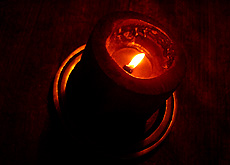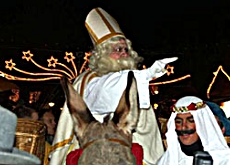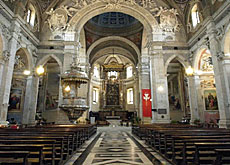Christmas presents a moveable feast

Christmas signifies different things to many different people, but ethnologist Jacques Hainard tells swissinfo that some traditions such as gifts are universal.
With its trees, lights and presents, it is a tradition that combines Jewish religion (Christ’s birth), Nordic culture (trees and Santa Claus) and Roman influence (December 25 and light).
swissinfo: The Christian Christmas falls around the same time as more ancient feast days – those of the Roman Saturnalia and the “Sol Invictus” of the cult of Mithra. Why has the time of the winter solstice always had such a strong influence?
Jacques Hainard: The barren landscape, the snow and the cold at this time of year are slightly foreboding. We need to feel warm, to generate a sense of hope that the coming year will be rich and fruitful. I think that’s why the Church chose to celebrate Christmas at this time. It’s a light in the darkness at the end of the year.
swissinfo: One thing, though, that has remained constant is the idea of exchanging gifts…
J.H.: At first they used to hang small gifts on trees. During the festivities, the tree was shaken and the gifts fell off. Then presents got bigger and heavier, so they ended up at the foot of the tree.
Among ethnologists, this display of generosity is often referred to as “potlatch”, according to a Native American custom. Among the Kwakiutl tribe, a person who had become prosperous would have to give away some of his belongings – canoes, blankets, copper ingots – during the potlatch ceremony. They were usually ruined by the end, but those who received a gift had to reciprocate, with interest if possible. Ethnologists found this a strange tradition until they realised that it was a way of balancing power.
Christmas involves a similar system: to receive, you have to give. And when you get a present, you have to work out how much it costs and give something equivalent or better in return. Today, the presents that give the most pleasure are perhaps those that don’t cost a lot but are original.
swissinfo: The celebration of Jesus’ birth was cleverly chosen to coincide with feast days highlighting renewal. But today renewal, the idea of a fresh start, tends to be synonymous with New Year.
J.H.: Christmas is intimate, a family affair, whereas New Year has become a public event when everyone gets together. There has definitely been a shift. It’s a bit like St Nicholas being confused with Santa Claus: Christmas, as a time of renewal, is now being confused with New Year.
swissinfo: The candles, the cake and the tree… these Christmas symbols have varied origins and their significance is largely forgotten. Do you think the Nativity could go the same way one day?
J.H.: I don’t think so. In 1956 part of Dijon’s population burnt Santa Claus in front of the cathedral. The mayor at the time, Canon Kir [after whom the aperitif is named], had to officially rehabilitate Santa Claus.
I think for most people Christmas remains a time of contemplation and spiritual reflection despite all the commercial aspects.
swissinfo: There are religious and family dimensions to Christmas. Yet the family has undergone profound change…
J.H.: Families can pose problems and for some people Christmas is a real headache. You don’t know who to invite and you don’t know who will come. There can be major arguments. I know people who find it a really difficult time of year.
swissinfo: So what does Christmas mean for Jacques Hainard?
J.H.: A good time. I’m often asked if I’m a believer, to which I say “yes”. I take a bit from every religion. I can be Buddhist, animist, anything I choose. Philosophically, I find religions highly intelligent and they fit in well with the aspirations of society. When you examine them closely, you can see why people were drawn to them at the time.
Christmas for me is a quality time when you eat and drink well – something I appreciate. And I like Christmas trees, probably because of the child within me, and I enjoy lighting the candles… It’s as simple as that.
swissinfo-interview: Bernard Léchot
Jacques Hainard, who was born in 1943, is the curator of the Neuchâtel ethnographic museum and lectures at the local university.
He is taking over as head of Geneva’s ethnographic museum in February 2006 for a three-year period.
His move to Geneva means giving up his job in Neuchâtel, where he has worked for the past 25 years.
According to Christian tradition, Christmas marks the birth of Christ.
Originally, it was set on January 6, Epiphany (still celebrated as the Orthodox Church Christmas), before Emperor Constantine shifted it 330AD to December 25.
It was only in 353AD that it actually became a celebration of the birth of Christ.
The move to December 25 was decided for political and religious reasons.
Before the advent of Christianity, the Romans held many religious feast days on and around December 25, including the Saturnalia and the Sol Invictus.

In compliance with the JTI standards
More: SWI swissinfo.ch certified by the Journalism Trust Initiative



You can find an overview of ongoing debates with our journalists here. Please join us!
If you want to start a conversation about a topic raised in this article or want to report factual errors, email us at english@swissinfo.ch.